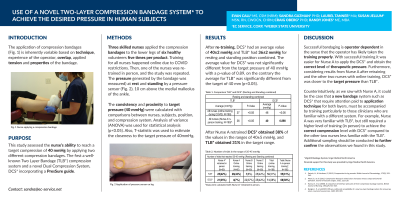Laboratory Research
(LR-003) Use of a novel two-layer compression bandage system to achieve the desired pressure in human subjects
Friday, April 28, 2023
7:15 PM - 8:30 PM East Coast USA Time

Sandra Guzman, PhD – Senior Test Engineer, EC Service, Corp.; Susan Jellum, MSN, RN, CWOCN, CHRN – Nurse, EC Service, Corp.; Randy Jones, MBA – Board Member, EC Service, Corp.; Craig Oberg, PhD – Distinguished Professor, Weber State University
Introduction: The application of compression bandages is inherently variable based on technique, experience of the operator, overlap, applied tension and properties of the bandage.
Under IRB approval, this study assessed the nurse’s ability to reach a target compression of 40mmHg by applying two different compression systems. The first, a well-known Two Layer Bandage (TLB*) compression system and a novel Dual Compression System, DCS* incorporating a pressure guide.
Methods: Skilled nurses applied the compression bandages to the lower legs of six healthy volunteers five times. The study was repeated in one of the nurses after re-training in person. The pressure generated by the bandage was measured at rest and standing, 10 cm above the medial malleolus of the ankle.
The consistency and proximity to target pressure were calculated with comparisons between nurses, subjects, position, and compression system. Analysis of variance (ANOVA) was used for statistical analysis (p< 0.05). Also, T-statistic was used to estimate the closeness to the target pressure of 40mmHg.
Results: After re-training, DCS* had an average value of 40±2 mmHg and TLB* had 36±2 mmHg for resting and standing position combined. The average value for DCS* was not significantly different from the target pressure with a p-value of 0.89, on the contrary the average for TBL* was significantly different from the target (p< 0.05). In total, DCS* obtained 38% of the values in the ranges of 40±5 mmHg, and TBL* obtained 30% in the target range.
Discussion: Successful bandaging to 40mmHg is operator dependent in the sense that the operator has taken the training properly. One of the nurses had extensive experience using TLB* and achieved higher values with DCS*, after re-training the nurse improved the values with DCS*. The other nurses who did not have experience with either system performed better with DCS*. Taken together, the results show that the pressure guide for the DCS* does allow more accurate application of target pressure that a system without such visual indicators. Additional sampling should be conducted to further confirm the observations we found in this study.
Under IRB approval, this study assessed the nurse’s ability to reach a target compression of 40mmHg by applying two different compression systems. The first, a well-known Two Layer Bandage (TLB*) compression system and a novel Dual Compression System, DCS* incorporating a pressure guide.
Methods: Skilled nurses applied the compression bandages to the lower legs of six healthy volunteers five times. The study was repeated in one of the nurses after re-training in person. The pressure generated by the bandage was measured at rest and standing, 10 cm above the medial malleolus of the ankle.
The consistency and proximity to target pressure were calculated with comparisons between nurses, subjects, position, and compression system. Analysis of variance (ANOVA) was used for statistical analysis (p< 0.05). Also, T-statistic was used to estimate the closeness to the target pressure of 40mmHg.
Results: After re-training, DCS* had an average value of 40±2 mmHg and TLB* had 36±2 mmHg for resting and standing position combined. The average value for DCS* was not significantly different from the target pressure with a p-value of 0.89, on the contrary the average for TBL* was significantly different from the target (p< 0.05). In total, DCS* obtained 38% of the values in the ranges of 40±5 mmHg, and TBL* obtained 30% in the target range.
Discussion: Successful bandaging to 40mmHg is operator dependent in the sense that the operator has taken the training properly. One of the nurses had extensive experience using TLB* and achieved higher values with DCS*, after re-training the nurse improved the values with DCS*. The other nurses who did not have experience with either system performed better with DCS*. Taken together, the results show that the pressure guide for the DCS* does allow more accurate application of target pressure that a system without such visual indicators. Additional sampling should be conducted to further confirm the observations we found in this study.

.png)